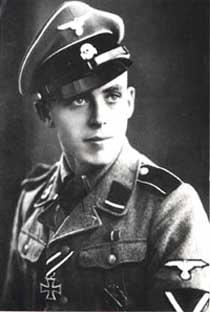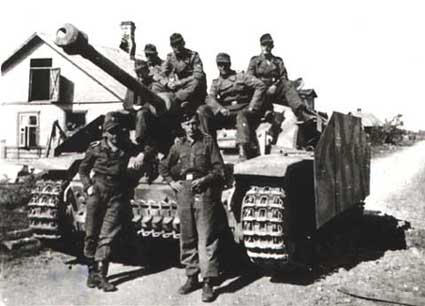By Max Cuypers
Johannes (Joop) Cuypers
Joop Cuypers was born in Amsterdam on 1 August 1920. Together with his brother Max, he was one of the first to enlist in the Waffen-SS Standarte "Nordwest", which mainly consisted of Flemish and Dutch volunteers. Their initial training was in the "Langenhorn barracks" near Hamburg. Their class took their oath of allegiance in the presence of Himmler on June 22, 1941. After further training in Debica in Poland and Arys in East Prussia, he would be assigned to the "Waffen SS Freiwilligen Legion Niederlande" and posted to the Leningrad sector, where he arrived in January 1942 north of lake Ilmen. He would receive a baptism of fire and would be forced to immediately prove himself in battle. Soon after the arrival of the Legion, the 2nd battalion infantry (Joop's) received orders to fill in the lines at Pjatilipy on the Wolchow, to absorb the Soviet attempt to break the siege of the city. All through February the new Legionaries resisted one wave of attack after another, in a frozen landscape with bitter cold temperatures as low as -50 C. The legion suffered horrendous casualties, since they absorbed most of the direct impact of the Russian offensive. Though they were well trained and determined, they were still new and inexperienced soldiers. The losses were enormous, but the casualties on the Soviet side were even worse. After weeks of close quarters, fierce fighting, the Soviets were initially able to advance but were eventually pushed back. In April, the spring marked the end of the Soviet winter offensive.

SS Oberschutze Johannes Cuypers (1942) wearing the Iron Cross 2nd Class, Easter Campaign Medal Ribbon and the Infantry Assault Badge
From his decorations it is obvious that Joop Cuypers distinguished himself in the course of these frozen battles. For his meritorious actions during the hard fighting in the Wolchow-Kessel region Joop was awarded the Iron Cross 2nd Class. The nature of the fighting was so close that he also qualified for the Infantry Assault Badge, which he also received. Finally, as a tribute to his endurance during this first horrible Russian winter, he was awarded the Winter Campaign Medal 1941-1942. Joop, now a veteran, had reached the rank of Rottenfuehrer (Corporal).
It was on 8 August 1942 that Joop was wounded. He stood too close to the fire-mouth of a PAK when it was fired. His eardrums were ruptured which deafened his left ear forever. Via first aid at the field hospital, Joop ended up in Waffen-SS hospital Braumschweig and from there was transferred to the Freiwilligen Ersatz Brigade der Waffen-SS in Graz, Austria. After recovery Joop had still suffered permanent hearing damage and was no longer suitable for infantry. A career change was in order. In January 1943, Joop was sent to France and transferred to the newly established 3rd company, SS-Sturmgeschuetz Abteilung 10, of SS Panzer Regiment "Frundsberg". It was here that he received his Panzer training.
During the summer of 1943 the III (Germanisches) SS-Panzer Korps was established. Joop was transferred once again from SS-Panzer Division "Frundsberg" and assigned to the SS-Panzerjaeger Abteilung 54 of the III (Germ.) SS-Panzer Korps. He attended the Unterfuehrerschulle in Grafenwohr and obtained the rank of Unterscharfuehrer. (Sergeant). He was given command of a Motorised Assault Gun (Sturmgeschuetz, or StuG III). The III (Germ) SS-Panzer Korps was first stationed in Croatia and took part in the fight against Tito's Communist partisans. In December of 1943, Joop, with the Korps was moved to the Leningrad sector (Oranienbaum salient) once again. On 11 January 1944 the Soviets launched a massive attack against the Northern front. The Germans were forced to retreat to Luga where they failed to establish a bridgehead. Under heavy fighting they were forced further back to the Estonian city of Narwa. Here they dug themselves in and were able to hold out to July 1944.

1943

SS Unterscharfuhrer Johannes Cuypers (front right with overseas cap). Narwa, July 1944.
It was during the later retreat, from Narwa to the Tannenberg Stellung, that he would be further decorated with the Iron Cross 1st Class, for his courageous but doomed efforts as StuG commander to break the encirclement of the 48th Regiment (Gen. Seyffardt) during their retreat from Narwa. The 48th regiment and part of the SS-Panzerjaeger Abteilung 54 were covering the retreat of the III (Germ) SS-Panzer Korps and were the last to evacuate Narwa. On the night of July 26, 1944 the 48th regiment was about to become surrounded and was running out of ammunition. They were on a swampy road between Soldino and Laagna facing increasing Russian pressure and with their heavy vehicles stuck in the mud. Joop and part of SS-Sturmgeschuetz-Alteilung 54 desperately tried to clear an escape road and were engaged in heavy fighting, but the Soviet pressure was too great. When the 48th regiment reached Laagna (in Soviet hands) they opened fire until all ammunition was exhausted. At 09.07 the last communication message was received, it read "will retreat in the western direction though the forest south of Laagna". Regiment 48 (Gen. Seyffardt) was now trapped behind enemy lines. Of the 3,000 men who composed it, only 27 survived
In the months August and September the fighting over the Tannenberg Stellung in Estonia continued. SS-Panzerjaeger Abteilung 54 desperately needed to be rebuild. From the originally 30 Guns there were only 4 left. On September 21, 1944 Joop was evacuated over sea from Pernau in Estonia to Koningberg in East Prussia. From Koningsberg he was sent to the Truppenuebungsplatz; Neuhammer am Queiss in Nieder Schlesien for the rebuilding of their unit. Here Joop reached his final rank of Oberscharfuehrer.
On February 10, 1945 SS-Panzerjaeger Abteilung 54 (#23 from there on) arrived with 3 new batteries of 10 StuG each in Pommerania. Joop however was not with them at the time. At the end of January Joop was called to Silesia where his Brother Max was killed in action. Max was at the time assigned as an instructor to the 3rd Battalion of 20./ Panzergrenadier Division der Waffen-SS (Estnische #1). The war situation in Silesia did not allow him to connect with his old unit. He fought with the Estonian Division in the battle for Oppeln. It was only when the Estonian Division was able to withdraw from Silesia that in early April 1945, Joop was transferred again, now for the last time to the Sturmgeschuetz Abteilung of the SS-Panzer Division "Frundsberg". One of his last fierce battles with "Frundsberg" was in and around the city of Dresden. In the final hectic days the division broke up in smaller groups in an attempt to get away from the Russians. Joop became separated from his unit, and surrendered to Americans at Annaberg in Saxony after learning that the war had ended. After spending time in American and French captivity, where they forced him to eat soap and clear land-mines without equipment, he was finally sent to Holland. The war tribunal in Maastricht sentenced him to three and a half years imprisonment for enlisting in a Foreign Service without her Majesty's approval. During this time he met his future (German) wife whom he married upon his release. A year later he had a son, Max. He lived a happy life to the age of 77.
![]()
© Copyright Wehrmacht-Awards.com LLC |
